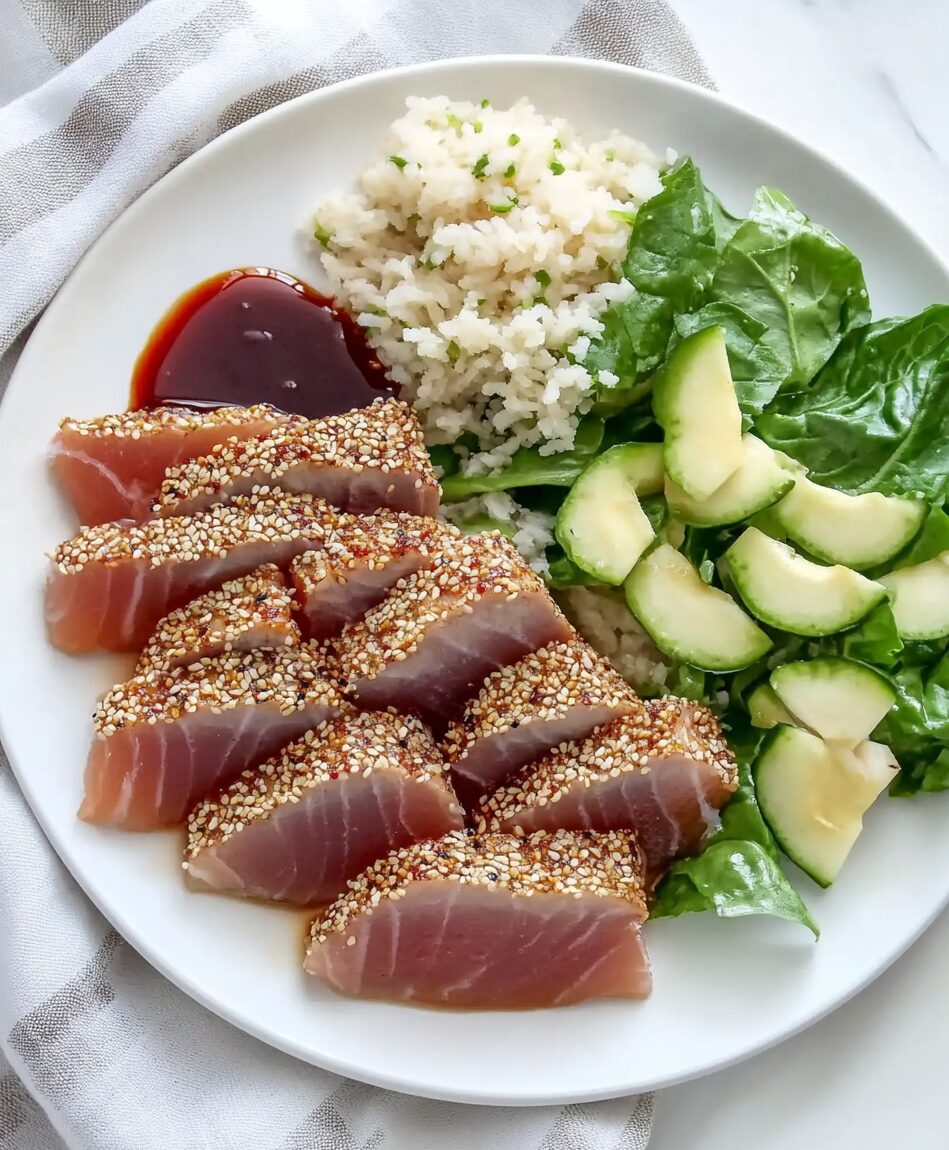Sesame Seared Tuna is a popular dish that highlights the delicate flavor of fresh ahi tuna. It’s a great option for those who appreciate simple yet sophisticated flavors. Here’s more detailed information about the dish:
Tuna Choice and Quality:
- Ahi Tuna (Yellowfin or Bigeye Tuna): The star of the dish, ahi tuna, is prized for its mild flavor and firm, meaty texture. When seared, it maintains a tender, almost buttery consistency in the center. It’s important to use sushi-grade tuna since the center remains rare, ensuring it’s safe to eat raw.
- Freshness is Key: Look for deep red or pink tuna with a firm texture. Fresh tuna will have minimal odor—just a slight hint of the ocean.
Cooking Technique:
- Searing: The technique involves quickly cooking the tuna steaks on high heat to create a beautiful, crunchy sesame crust while leaving the inside rare or medium-rare. The contrast between the crispy sesame seeds and the tender fish makes the dish particularly satisfying.
- Temperature Control: Overcooking the tuna will cause it to lose its delicate texture. To achieve the perfect sear, ensure your pan is hot before adding the tuna, and cook it for just 1-2 minutes per side. You want the exterior to be golden brown, while the inside should remain pink or red.
Flavor Balance:
- Soy Sauce & Mirin: These ingredients give the marinade a balance of salty and sweet, infusing the tuna with a rich umami flavor.
- Sesame Oil: Adds a nutty depth, complementing the sesame seeds on the outside.
- Rice Wine Vinegar: A slight touch of acidity helps balance the richness of the tuna and sesame seeds, brightening the overall flavor.
Sesame Seed Coating:
- Texture and Appearance: The sesame seeds not only provide a delightful crunch but also add visual contrast. Using both black and white sesame seeds makes the dish look more striking, especially when sliced thinly.
- Health Benefits: Sesame seeds are a good source of healthy fats, protein, and antioxidants, adding nutritional value to the dish.
Pairing Suggestions:
- Side Dishes: Steamed jasmine rice, cucumber salad, or roasted vegetables all pair well with seared tuna. For a more traditional Japanese feel, try serving it with miso soup or edamame.
- Beverages: A light, crisp white wine like Sauvignon Blanc, or a chilled sake, complements the freshness of the tuna. For a non-alcoholic option, green tea or sparkling water with lemon would work beautifully.
Health Benefits:
- High in Protein: Ahi tuna is an excellent source of lean protein, making it ideal for those looking to maintain or build muscle, or simply follow a high-protein diet. Each serving provides around 24-25 grams of protein, which is essential for muscle repair, immune function, and overall energy.
- Rich in Omega-3 Fatty Acids: Tuna is loaded with omega-3 fatty acids, which are beneficial for heart health, reducing inflammation, and promoting brain function.
- Low in Carbohydrates: For those following a low-carb or keto diet, seared tuna is a perfect option as it is naturally low in carbohydrates while being packed with essential nutrients.
- Sesame Seeds: These tiny seeds are not only flavorful but are a good source of healthy fats, fiber, calcium, magnesium, and antioxidants, contributing to overall heart health and digestion.
Serving Ideas:
- Tuna Salad: Serve the seared tuna slices over a bed of greens with avocado, cucumber, and radishes for a refreshing, light salad. Drizzle with a ginger-sesame dressing for a cohesive flavor.
- Tuna Tacos: Place thin slices of sesame-seared tuna in soft tortillas with shredded cabbage, avocado, and a drizzle of lime crema or spicy mayo for a creative twist on tacos.
- Sushi Bowls: For a deconstructed sushi experience, serve the seared tuna over sushi rice with pickled ginger, seaweed salad, edamame, and sliced vegetables. Add soy sauce or ponzu for extra flavor.
- Appetizer: Slice the seared tuna thinly and serve it as an appetizer with a dipping sauce made from soy sauce, sesame oil, and a dash of rice vinegar.
Cooking Tips:
- Pat Dry the Tuna: Before searing, make sure to pat the tuna dry with a paper towel after removing it from the marinade. This ensures a crisp, golden sear instead of a soggy crust.
- Searing Time: It’s important to only sear the tuna for a short time (1-2 minutes per side) to prevent overcooking. You want the sesame seeds to toast, but the inside of the tuna should remain rare to maintain its tenderness.
- Rest Before Slicing: After searing, let the tuna rest for a minute or two before slicing. This will help the juices redistribute evenly, keeping the tuna moist and flavorful.
Storage and Leftovers:
- Storage: While this dish is best eaten fresh, you can store leftover seared tuna in an airtight container in the refrigerator for up to 1-2 days. Make sure the tuna is fully cooled before storing to prevent sogginess.
- Reheating: Avoid reheating the tuna as it may overcook and lose its texture. Instead, enjoy it cold by adding the slices to salads or bowls, or serve it in tacos.
Nutritional Information:
This dish is high in protein and healthy fats while being relatively low in calories, making it an excellent choice for those following a balanced, low-carb, or high-protein diet.
Conclusion:
Sesame Seared Tuna is a delicious and nutritious dish that brings together the rich flavors of soy sauce, sesame seeds, and fresh ahi tuna. It’s quick to prepare, making it perfect for both weeknight dinners and special occasions. With a crispy sesame crust and a tender, rare center, this recipe offers a delightful contrast in textures and a burst of umami flavor. Whether served with a light salad, over rice, or in tacos, this versatile dish is sure to impress with its simple yet elegant presentation and health benefits






